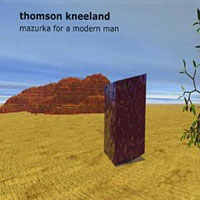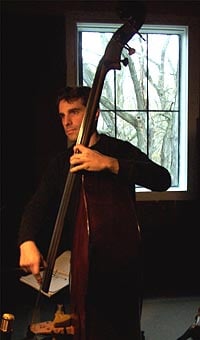A Review of Thomson Kneeland’s “Mazurka for a Modern Man”
 There is a special symbiosis that occurs when a bassist and drummer work together on projects for significant lengths of time. When those musicians are as great as the ones on this record, the results can be wonderful. Mazurka for a Modern Man, in part, is a documentation of such a symbiosis. It’s a wonderful contemporary jazz record, imbued with a shared love for Balkan music, Indian music and other influences.
There is a special symbiosis that occurs when a bassist and drummer work together on projects for significant lengths of time. When those musicians are as great as the ones on this record, the results can be wonderful. Mazurka for a Modern Man, in part, is a documentation of such a symbiosis. It’s a wonderful contemporary jazz record, imbued with a shared love for Balkan music, Indian music and other influences.
Thomson Kneeland is a formidable bassist and composer, and he worked with the core of this band regularly for ten years as they developed their own vocabulary and shared creative approach. Kneeland formed a special musical relationship the brilliant drummer/percussionist Take Toriyama, who sadly passed away weeks after these tracks were recorded.
The New England-raised Kneeland has been immersed in music from an early age. He has played in a wide range of contexts and has studied with Jerry Bergonzi, Paul Bley and others. He is deep thinker, versed in the history of jazz double bass. Some of his insightful writings about music can be found on his home page. As a sideman, Kneeland has worked with Kenny Werner, Bergonzi, Chris Potter, Rick Margitza, Gunther Schuller, Paul Bollenback and many others. Now a resident of New York, he is involved in a wide range of projects, from string quartets to solo bass to jazz ensembles.
Mazurka for a Modern Man grabbed me from the outset. “Ashlayah”, the opener, has a marvellous Klezmer-inspired melody and a swinging 6/8 pulse with a bouncing rhythm as the solid, profound playing of Kneeland dances with the effervescent, sensitive and reactive drumming of Toriyama. Toriyama creates a shimmering pulse that grooves steadily as it evolves, constantly changing, shifting and commenting. Radley plays a delightful modal solo that develops well, and Toriyama is featured in a rolling, tumbling drum solo after Stillman’s searching alto saxophone statement.
“Hyperion”, the name of a Greek God of Light/Wisdom, is inspired John Keats’ poem. It begins with a sublime slow single note guitar pattern with delicate brushwork from Toriyama before Kneeland’s majestic bass enters and Smith’s bittersweet trumpet sings the melody. A combination of exquisite writing and delicate sensitive trumpet playing sets up a mood of intense reflection which is heightened by Kneeland’s lyrical bass solo, exquisitely phrased and developed. He has a keen sense of the architecture of his solos, building slowly and taking the listener with him in his story. As the track draws to what you presume to be the close after the return of the melody, Nate Radley (who studies with John Abercrombie) begins his own sensitive meditation on the theme.
A “Mazurka” is a Polish dance in three with a specific rhythmic feel. “Mazurka for a Modern Man” features Toriyama’s expansive drumming over a gorgeous three. The tone poem contrasts two moods: the lighter jazzy beat, and a rock influenced section. David Smith plays the plaintive melody sections on trumpet which alternate with tense six string chords from Radley. Toriyama really gets to play expressively over passionate bass work from Kneeland and the intense guitar chords.
“Diphyramb” is named after a type of ecstatic Greek hymn sung by a choir honoring Dionysus. The hymn-like intro contrasts with a Balkan inspired groove with sinuous horns over chiming guitar chords and intense propulsive bass. The solos reflects Kneeland and Toriyama’s knowledge of Indian Karnatic music. Stillman plays keening and serpentine alto lines over a backdrop that gradually increases in intensity to a rolling crescendo. Kneeland’s bass solo over the drummer’s accompaniment is intense, propulsive and dramatic as the bassist builds his solo to a climax using South Indian classical lines which are then played in unison with Radley. There’s still time for a brilliant drum solo before the track ends.
“Moja Tesknota” is an effective change of pace. The traditional Polish melody is played by a Chamber group consisting of trumpet, violin, viola, double bass and accordion. The melody is exquisitely played by the ensemble and beautifully arranged. Evan Harlan’s accordion playing is a particular delight. Trumpet and violin play beautifully and the bass sits perfectly with long resonant notes. The song (which translates roughly as ‘my sad little girl’) is dedicated to Kneeland’s mother.
The Drum and Bass inspired “Libretto” features intricate Bach-inspired counterpoint and Toriyama’s intense drum work. Stillman plays a bright, intense solo and Radley solos spikily and fluently but the arrangements on this track are what lift it as combinations of complex written parts build over one another to create an intense web of music.
The band share a love of Balkan music (particularly that of Bulgaria) and “Nebuchadnezzar” reflects that. It uses various Balkan meters (5, 7 and 11) and a Balkan influenced plaintive trumpet melody. Smith also plays a dramatic extended improvised trumpet introduction. The Kopanitsa (Bulgarian rhythm in 11/8 divided 22322) is particularly effecting with chiming guitar chords and bass and drums interacting beautifully. There is a lovely guitar solo before Kneeland takes a turn, developing an intense rhythmic solo.
“Rhapsody (for Take Toriyama)” is a beautiful, knowing rock influenced ballad. David Smith’s trumpet plays the lyrical melody and a yearning solo as the band build beneath him using space and silence to great effect. Kneeland’s bass solo is lyrical and atmospheric and reflects on the melody of the theme. I find it a deeply affecting theme and the power of the melody is enhanced by the writing for guitar which complements the trumpet line extremely effectively.
“Crus Bifurcatus” has a drum and bass influence with a serpentine horn melody and some especially neat bass work. The horns take turns to solo over Toriyama’s effervescent and bubbly drumming later joined by Kneeland’s basswork to create an intense groove. The horns continue to alternate until they combine in collective improvisation over the bubbling groove. The melody returns and then we are led by the guitarist on his own interpretation of the tune, using delay effectively to create a rich sonic tapestry. It’s a great tune to end a record with.
So this is a fine tribute to an extraordinary musician (Take Toriyama), a document of a band who created their own musical vocabulary collectively, a vital jazz record with unique textures and arrangements and a great introduction to composition and bass playing of Thomson Kneeland.
Mazurka for a Modern Man is available on Amazon.
Preview and download Mazurka for a Modern Man:
Mazurka for a Modern Man Track List
- Ashlayah
- Hyperion
- Mazurka for a Modern Man
- Dithyramb
- Moja Tesknota (for Deborah Zelazny)
- Libretto
- Nebuchadnezzar
- Rhapsody (for Take Toriyama)
- Crus Bifurcatus
Mazurka for a Modern Man Line-up
- Thomson Kneeland – double bass
- Take Toriyama – drums, percussion
- Nate Radley – guitar
- David Smith – trumpet
- Loren Stillman – alto saxophone (on 1, 4, 6, 9)
On Moja Tesknota:
- Jerry Sabatini – trumpet
- Evan Harian – accordion
- Eric Bindman – violin, viola
- Mike Connors – drums

